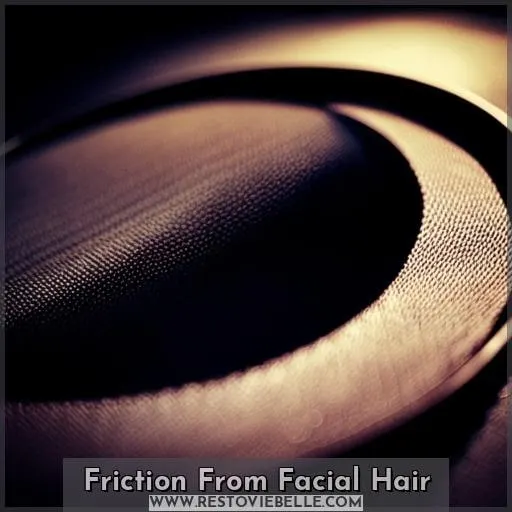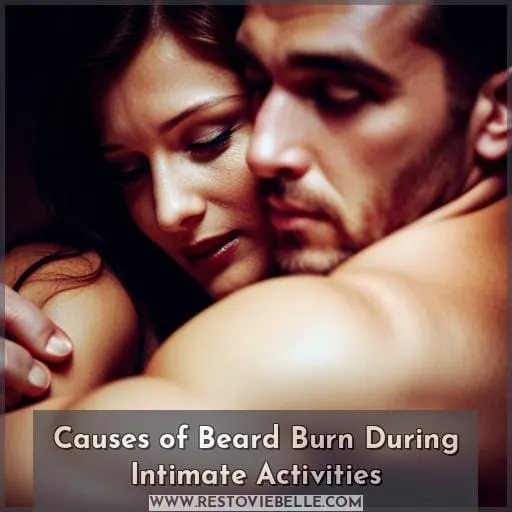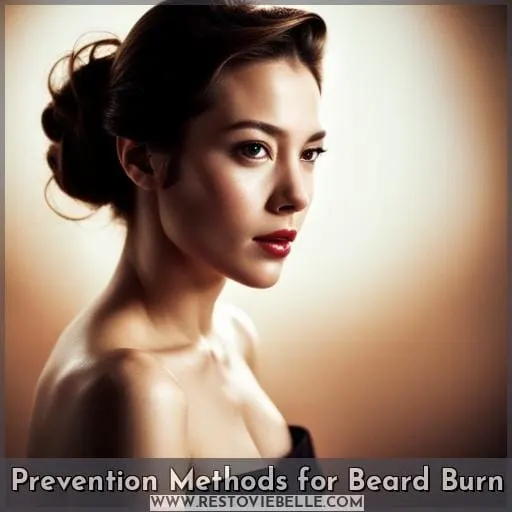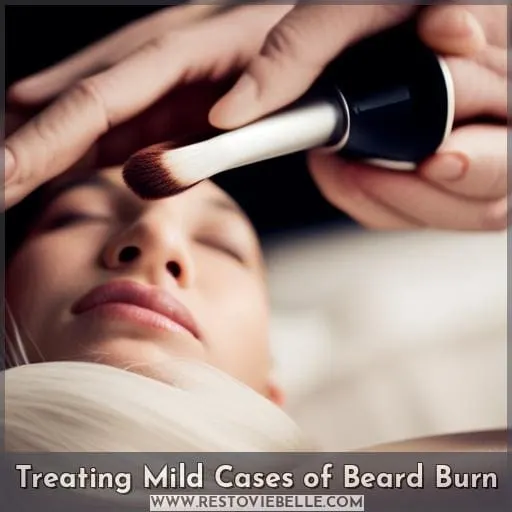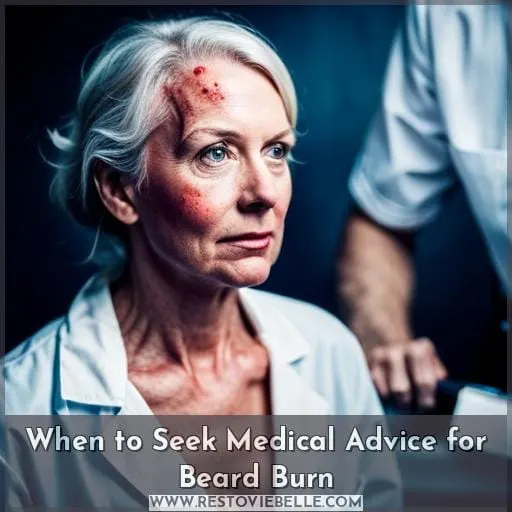This site is supported by our readers. We may earn a commission, at no cost to you, if you purchase through links.
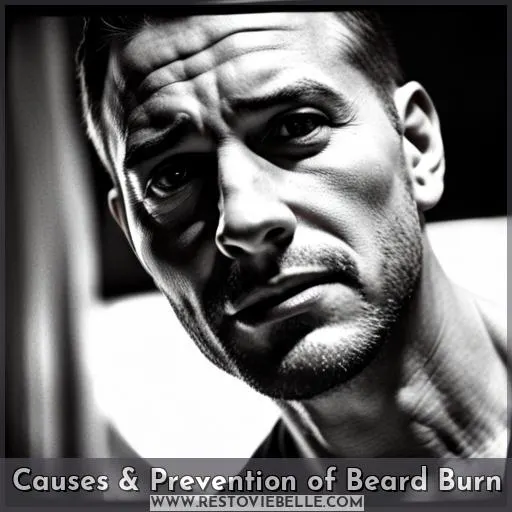 Are you feeling the burn? It’s not just a funny phrase; it can be an uncomfortable reality. Beard burn is caused when skin comes into contact with facial hair, and if left untreated, it can lead to more serious conditions like contact dermatitis or genital beard burn.
Are you feeling the burn? It’s not just a funny phrase; it can be an uncomfortable reality. Beard burn is caused when skin comes into contact with facial hair, and if left untreated, it can lead to more serious conditions like contact dermatitis or genital beard burn.
To ensure you don’t get caught out by this pesky problem, we’ll explore what causes beard burn and how to prevent and treat it in this article.
Table Of Contents
- Key Takeaways
- Friction From Facial Hair
- Factors That Increase Risk of Beard Burn
- Causes of Beard Burn During Intimate Activities
- Prevention Methods for Beard Burn
- Treating Mild Cases of Beard Burn
- Seeking Medical Treatment for Severe Cases
- Potential Complications of Beard Burn
- When to Seek Medical Advice for Beard Burn
- Conclusion
Key Takeaways
- Friction between facial hair and skin causes beard burn.
- Coarse facial hair and a lack of grooming increase the risk of beard burn.
- Intimate activities with friction can also increase the risk of beard burn.
- Symptoms of beard burn include redness, dryness, itching, and potential rashes.
Friction From Facial Hair
You experience irritation and discomfort from the abrasion of your partner’s facial hair against your skin. This is known as beard burn, or stache rash, and is caused by friction between facial hair and skin.
Shorter, coarser facial hair can cause more irritation than longer hairs due to increased levels of friction.
Symptoms include redness, dryness, itching – which may progress to swollen painful rashes in severe cases – and an open sore vulnerability if left untreated for too long. Prevention involves keeping a barrier cream or moisturizer on hand before close contact with someone sporting some stubble.
Also, having partners maintain softer beards through oils and conditioners helps reduce potential chafing sensations associated with beard burn.
Remedies for milder cases include using oil-free creams like CeraVe or Vanicreams. Hydrocortisone creams work best when symptoms are painfully severe. Oatmeal baths containing anti-inflammatory properties are recommended for soothing relief, alongside other topical applications featuring calming ingredients like aloe vera and chamomile extractions.
Factors That Increase Risk of Beard Burn
When it comes to beard burn, or stache rash, shorter and coarser facial hair can cause more irritation. Lack of grooming and engaging in intimate activities with friction are both factors that increase the risk of this condition.
Short
Be aware that shorter, coarser facial hair can increase the risk of a stache rash. Grooming benefits include using oil and conditioners to make it softer, while moisturizers help protect sensitive skin from friction burn.
- Short beards are more likely to cause skin irritation than longer ones.
- Coarse hairs require extra care for grooming.
- The effectiveness of moisturizer depends on its composition and frequency of application.
- Razor burn is another side effect of shaving too close or often.
- Regularly check your beard for any signs of redness or inflammation as they may indicate an increased risk for beard burn!
coarse facial hair
Coarser facial hair can irritate your skin more and increase the risk of stache rash. Shorter, coarser hairs may cause greater friction when they rub against your face or neck – resulting in a burning sensation.
To reduce these risks, groom regularly with beard oils and conditioners to soften hairs for less irritation and razor bumps! Dry skin should be treated with moisturizers too, reducing both itchiness and dryness from contact dermatitis that often accompanies beard burn.
Lack of grooming
Not grooming your facial hair properly can lead to an increased risk of beard burn. Using a moisturizing cream or hydrocortisone cream, as recommended by your dermatologist, is essential for skin health and irritation prevention.
Grooming is important for keeping the facial hair soft, preventing split ends, and promoting proper hydration benefits. Taking care of your beard also prevents dryness, which can exacerbate the chances of developing stache rash due to friction between the skin and hairs.
Intimate activities with friction
Intimate activities with friction can increase your risk of beard burn. A long, groomed beard can reduce irritation. Use a skin protectant or moisturizer before contact to minimize discomfort and apply a soothing balm afterward to soothe inflamed areas.
If you experience any signs of irritated skin, use hydrocortisone creams for relief and consult your doctor if symptoms persist longer than two weeks.
Causes of Beard Burn During Intimate Activities
During close contact, the friction between your skin and your partner’s facial hair can trigger beard burn. Prevention strategies include using lotions or creams to manage skin sensitivity and reduce chances of irritation.
Friction reduction techniques can also help, such as avoiding certain intimate activities, encouraging partners to groom their facial hair properly, and applying barrier creams before close contact.
Partner communication is important in preventing beard burn during intimate activities like kissing or receiving oral sex. Discussing preferred methods and strategies can help both partners avoid discomfort.
Practicing safe sex is crucial, as severe cases of beard burn can cause breaks in the skin, increasing the risk of infection. Being aware of signs of STI symptoms in either partner is important for early detection and treatment.
Taking proactive measures against unwanted side effects from intimacy is key to maintaining your health while enjoying physical closeness with someone else!
Prevention Methods for Beard Burn
Beard burn, or stache rash, is a common issue caused by friction between facial hair and the skin. To prevent this irritation from occurring in the first place, proper grooming and trimming techniques, as well as using barrier creams and moisturizers, can be employed.
Grooming and Trimming Techniques
To help prevent beard burn, it’s important to practice proper grooming and trimming techniques. Trim facial hair with a sharp razor and use aloe vera products for extra soothing protection. Avoid irritant contact dermatitis by selecting the right razor type for your face shape and beard length.
Styling tips, such as using longer facial hair, can also reduce friction on the skin surface.
Using Barrier Creams and Moisturizers
You can reduce the risk of stache rash by applying a barrier cream or moisturizer before close contact. Barrier creams provide an extra layer of protection between the skin and facial hair, while moisturizers are essential for keeping beard burn at bay.
Selecting the right product is key – look for ingredients like aloe vera or chamomile to alleviate itching and redness. Applying generously may help minimize irritation further, but be careful not to get it into your eyes! With proper care and attention, these protective measures can offer relief from painful rashes associated with beard burn.
Avoiding Activities That Cause Friction
By limiting activities that create friction on your skin, you can effectively avoid beard burn. Safe sex is an important factor in preventing genital rash and other contact allergies associated with facial hair.
Intimate hygiene should be maintained to reduce the risk of infection or breakage of the skin.
If symptoms persist beyond a week or two, it’s recommended to consult a dermatologist for more comprehensive treatments such as topical antibiotics.
Recovery from beard burn also involves cleansing affected areas with gentle soap and applying soothing creams or lotions regularly until symptoms subside completely.
Treating Mild Cases of Beard Burn
Treating mild cases of beard burn can be managed with the use of moisturizing creams and ointments, as well as over-the-counter hydrocortisone creams. Such treatments are designed to reduce redness, dryness, and itching that may occur due to facial hair rubbing against the skin.
Moisturizing Creams and Ointments
Slathering on moisturizers and ointments can help soothe the itchy, inflamed skin caused by facial hair friction – just don’t skimp on your aftercare regimen! Over-the-counter hydrocortisone creams are effective for mild cases of beard burn.
Moisturizers with soothing ingredients like chamomile or aloe vera, plus gentle cleansers and oatmeal baths, can provide relief too. Severe cases may require a corticosteroid cream prescribed by a dermatologist to reduce redness and itching.
Over-the-Counter Hydrocortisone Creams
Applying a mild hydrocortisone cream can help reduce redness and itching associated with beard burn. Hydrocortisone is an effective anti-inflammatory agent that may be available over-the-counter or prescribed by a doctor depending on the severity of the rash.
It’s important to follow instructions as certain skin reactions may occur when used long term, such as thinning of the skin or discoloration.
Proper application also plays an important role in effectiveness. Use small amounts in affected areas two to three times per day, unless instructed otherwise by your physician. With proper usage and monitoring, hydrocortisone creams can provide relief for mild cases of beard burn without resorting to costly alternatives like steroids or antibiotics.
Seeking Medical Treatment for Severe Cases
Beard burn, also known as stache rash, is a common issue caused by friction between facial hair and the skin. In severe cases of beard burn, medical treatment may be necessary to reduce the risk of infection and aid in healing.
Prescription-Strength Hydrocortisone or Steroid Creams
If your severe beard burn persists for longer than a week or two, you may need to consult with a doctor for prescription-strength hydrocortisone or steroid creams. These creams can help reduce redness and itching. Topical steroids are applied directly to the affected area and provide effective relief from symptoms like redness and inflammation.
In some cases, a dermatologist may need to evaluate your condition before prescribing cream treatments. Don’t wait until your rash becomes too painful; seek medical advice if the irritation continues beyond what can be reasonably treated at home.
Cleansing and Soothing Products
Cleansing the affected area with a gentle, fragrance-free cleanser and using creams or lotions containing soothing ingredients like chamomile or aloe vera can help relieve stache rash. To ensure your skin heals properly, cleanse it regularly, use products to soothe irritation, and seek advice from a dermatologist if needed.
Cleansing tips, calming remedies, product recommendations, and consulting a doctor are key steps to optimally treating beard burn.
Oatmeal Baths for Relief
Soothe your stache rash with an oatmeal bath. Its anti-inflammatory properties reduce discomfort and speed up skin healing. Benefits also include moisturizing, reducing redness, and relieving itching sensations.
Add baking soda or essential oils to enhance the therapeutic effect of the bath! Try other relief methods as well, such as conditioners, creams, and lotions containing soothing ingredients like chamomile or aloe vera for better results.
Potential Complications of Beard Burn
It is essential to be aware of the potential complications that can arise from beard burn. Contact dermatitis, facial or genital beard burns, and safe sex practices are all things to consider when experiencing this issue.
Severe cases may require medical attention in order to ensure proper treatment and prevention of further infection.
Contact Dermatitis
Contact dermatitis can result from severe beard burn, causing painful and inflamed rashes.
- Hydrocortisone creams to reduce redness and itching
- Soothing products such as chamomile or aloe vera cream/lotion
- Oatmeal baths with anti-inflammatory properties for relief. Preventive measures include moisturizing the skin before close contact, longer facial hair, and grooming with conditioners. Safe sex practices are essential to avoid infections through breaks in the skin. Symptoms should be managed promptly for optimal results.
Genital Beard Burn
If you’re experiencing intense itching and redness in your genital area, it could be a sign of genital beard burn. Applying Vaseline can provide temporary relief, but regular grooming is key to preventing future outbreaks.
Moisturizers after close contact are also beneficial for avoiding irritation. Genital beard burn can cause acne on the face, so using gentle cleansers and oil-free moisturizers will help reduce breakouts.
Keeping facial hair soft with conditioners or oils may further decrease the risk of discomfort in intimate areas due to friction from coarser hairs.
Safe Sex Practices
To protect yourself and your partner from the potential complications of beard burn, practice safe sex by using condoms or dental dams. Genital rash caused by facial hair friction can increase the risk of skin infections.
Change positions often to reduce irritation and use lube for extra comfort. Avoiding intimate activities that cause friction is also key in reducing the chances of beard burn on any part of the body.
When to Seek Medical Advice for Beard Burn
If your beard burn persists beyond a week or two, it’s time to seek medical advice. Prolonged discomfort can be a sign of severe beard burn and should be evaluated by a dermatologist as soon as possible.
Medical evaluation is essential for determining the best treatment options for reducing inflammation and discomfort associated with persistent symptoms. It may also help identify any risk factors that could lead to further complications if left untreated.
A doctor will likely prescribe prescription-strength hydrocortisone creams or topical steroid creams to reduce redness and itching in order to promote healing from within the skin layers rather than just treating surface-level irritation.
In addition, they may recommend lifestyle changes such as avoiding activities that result in friction against facial hair or using barrier cream before intimate contact to prevent further outbreaks of beard burn over time.
Don’t wait until you’re uncomfortable; seeking professional assistance can bring much-needed relief quickly while helping you avoid potential future issues related to prolonged exposure without proper treatment methods being put into place first.
Conclusion
Beard burn, or stache rash, is a common and uncomfortable irritation caused by friction between facial hair and skin. It’s important to be aware of the factors that increase the risk of beard burn, such as short, coarse facial hair, lack of grooming, and intimate activities that involve friction.
To prevent beard burn, it’s important to groom and trim facial hair, use barrier creams and moisturizers, and avoid activities that may cause friction. Mild cases of beard burn may be treated with moisturizing creams and ointments, as well as over-the-counter hydrocortisone creams.
For more severe cases, it’s important to seek medical treatment. Complications of beard burn may include contact dermatitis and genital beard burn, so practicing safe sex is crucial to prevent potential infections through breaks in the skin.
If symptoms persist, it’s important to seek medical advice about beard burn.

